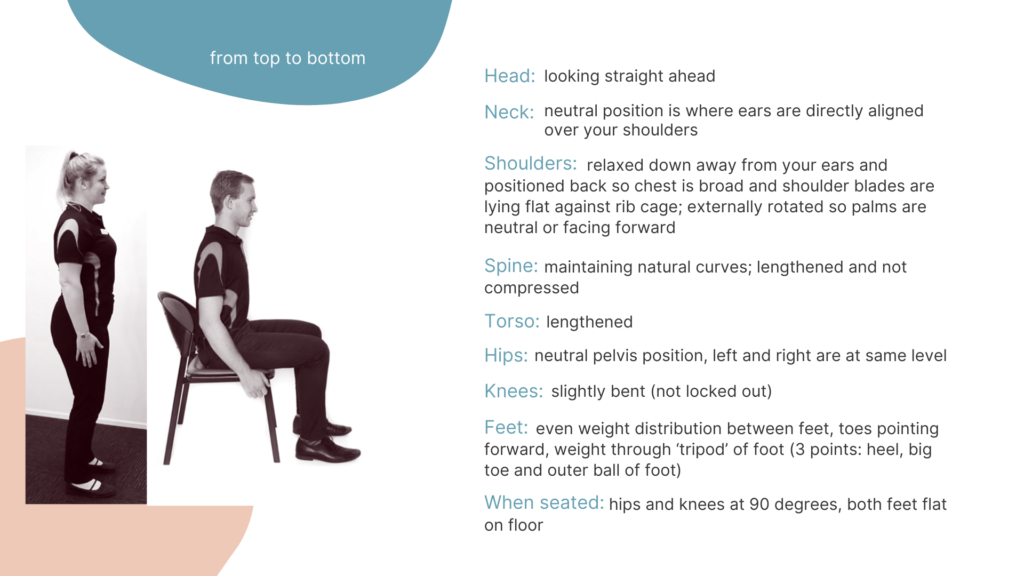
Sophie Pacek
Exercise Physiologist, Healthy Connections
Welcome back to part two of improving your posture! If you missed last week’s blog, a brief recap is as follows:
- Posture is complex – we assume many postures throughout the day
- Optimal posture is all about balance between muscles
- Posture changes when we develop bad habits and muscles become underactive or overactive - this may lead to pain, arthritis and structural abnormalities
- The Upper and Lower Crossed Syndromes are concepts used to assist health professionals on understanding common postural abnormalities and how to reduce associated pain (Page, Frank & Lardner, 2010)
- Refer to my step-by-step guide to improving your posture here
In today’s blog, I am going to elaborate on the concepts explored last week and provide you with some specific postural exercises.
What does good posture look like?
Optimal standing posture consists of a position that achieves neutrality and balance between agonist and antagonist muscles (refer to last week’s blog on what these muscles are).

The golden rule (in most cases)
Think of posture as a pulley system between opposing muscles. If one muscle group is tight or overactive (thus usually short in length), they will pull the body into a position where the antagonist muscle group is pulled longer (thus usually becomes underactive/weak). Therefore, we want to aim to STRENGTHEN or ‘wake up’ the sleepy underactive muscles whilst STRETCHING or ‘soothing’ the uptight overactive muscles.
Note: In some cases, muscles can be short and weak. For example, if you start to work a muscle beyond its capacity, it can tighten and strain (e.g. lifting a heavy box using your small back muscles). Therefore, it is important that we assume correct postures and techniques to ensure muscles are doing what they are designed to do.
Exercise time!
The video provides some foundational exercises to address postural abnormalities and to assist with easing tightness and/or muscular pain using the strengthen/stretch golden rule. Remember: go at your own pace and ability – this is a general program (some exercises may not be suitable for you) so I encourage those of you who have specific goals/needs to seek individual advice from Healthy Connections.
Starting with postural exercises for our upper body, we then move onto our lower body at timeframe 16:10.
Healthy Connections, operating under Burnie Brae Ltd, have created this video for exercise education and entertainment purposes. This video is intended as a guide only, and in no way does the information it contains replace any professional advice you may receive. In performing any fitness exercises, you are performing them at your own risk. Please consult with your doctor before undertaking any new exercise regime, fitness program, fitness video or following information shared by us. Healthy Connections, operating under Burnie Brae Ltd will not be responsible or liable for any injury or harm you sustain as a result of our online fitness videos or information shared on our website.The intellectual property of this video content belongs to Burnie Brae Ltd and must not be shared without written consent.
A public interest announcement: It's 'Exercise Right' week!
Before I sign off, I would like to take this opportunity to let you know that this week is Exercise Right Week! Every year, Exercise and Sports Science Australia (the peak body for exercise physiologists and sports scientists) host this campaign to inspire Australians to get active and exercise right. This year’s theme is “Movement is Medicine” – just like having medication prescribed for certain health conditions, exercise can too be medicinal and beneficial for everyone regardless of age, weight, background or health status (ESSA, 2020).
There is a range of free exercise sessions, education events, Q&A sessions and blogs being hosted this week, so be sure to check out the Exercise Right Week website here.
In a nutshell: there are limitless ways to keep physically active, we all just need to keep moving. Like my partner often says, “The only bad workout is the one that didn’t happen”.
Happy exercising, stay safe and keep moving!
Sophie
- ESSA. (2020). Exercise Right Week. Retrieved from https://exerciseright.com.au/exercise-right-week-campaign/
- Page, P., Frank, C. C., & Lardner, R. (2010). Assessment and Treatment of Muscle Imbalance: The Janda Approach. Human Kinetics: Champaign, IL.



